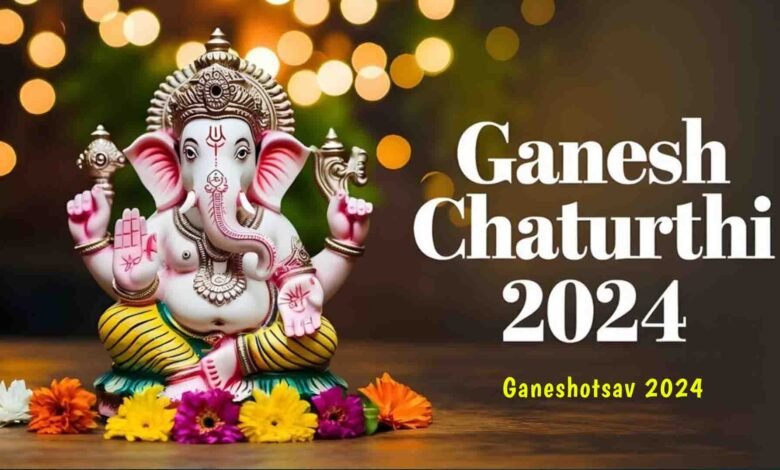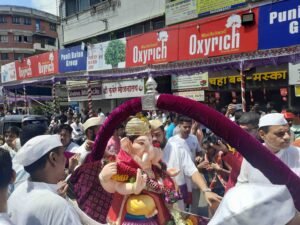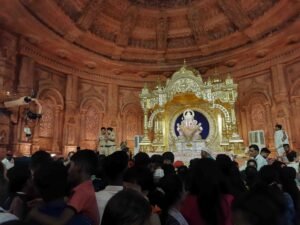
Ganesh Chaturthi: Ganesh Chaturthi, also known as Vinayaki Chaturthi, is one of the most cherished festivals in Maharashtra and across India. Celebrated on the Chaturthi Tithi of Shukla Paksha in the Hindu month of Bhadrapada, this 10-day festival honors Lord Ganesha, the deity of wisdom, prosperity, and the remover of obstacles. With grand processions, colorful decorations, and deep devotion, Ganesh Chaturthi holds a special place in the hearts of millions of devotees.
Ganesh Chaturthi Date and Significance
In 2024, Ganesh Chaturthi will be observed on September 7th. This day is of immense importance in the Hindu calendar, as it marks the birth of Lord Ganesha, who is believed to bless devotees with wisdom, good fortune, and success. According to the Vedas, Lord Ganesha is known by 108 different names, symbolizing his various forms and divine roles.

Ganesh Chaturthi, celebrated in Maharashtra, Goa, Telangana, and other parts of India, is a time when families and communities come together to install Ganesha idols in their homes and public pandals (temporary stages). The festival begins with the ceremonial installation of the idol, followed by prayers, offerings, and rituals that continue for 10 days, culminating in the grand Ganesh Visarjan (immersion of idols in water).
Historical Roots of Ganesh Chaturthi
The festival has a rich history, dating back to the times of Chhatrapati Shivaji Maharaj, who popularized Ganesh Chaturthi as a public event to unite people in the Maratha kingdom. It gained further prominence during the British colonial period, when Indian freedom fighter Lokmanya Tilak transformed Ganeshotsav into a large public event to foster unity and nationalism among the people.
Traditionally, Lord Ganesha is worshipped before starting any auspicious venture, as he is considered the Vighnaharta (remover of obstacles). During the 10-day celebration, devotees install idols of Ganesha in their homes for periods ranging from one and a half days to 11 days, depending on their family tradition.
The Arrival of Bappa: Festive Preparations
Weeks before Ganesh Chaturthi, preparations begin with the setting up of mandaps (temporary stages) and beautiful decorations. Artisans craft Ganesha idols of varying sizes, with many families choosing eco-friendly clay idols to honor nature. The streets of cities like Mumbai and Pune come alive with the sounds of dhol (drums) and the vibrant energy of devotees eagerly awaiting the arrival of “Bappa” (as Lord Ganesha is fondly called).

The rituals start with the Pran Pratishtapana, a ceremony that invites Lord Ganesha to reside in the idol. Throughout the festival, aarti (devotional songs) and special prayers are offered daily, with devotees praying for wisdom, prosperity, and peace in their homes and communities.
Significance of the Ganesh Visarjan
The conclusion of Ganesh Chaturthi is marked by the Visarjan (immersion) of Lord Ganesha’s idol in water bodies such as rivers, lakes, or the sea. This ritual symbolizes the cycle of birth, life, and death, as well as the belief that Ganesha returns to his heavenly abode, taking with him the troubles and worries of his devotees.
According to legend, Maharishi Vyasa prayed to Lord Ganesha to assist him in writing the Mahabharata. Lord Ganesha agreed and continuously wrote the epic for 10 days. At the end of this period, a layer of dust gathered on his body, which was cleansed by bathing in the Saraswati River on Anant Chaturdashi (the 14th day of Shukla Paksha). This act of purification became the foundation of the Visarjan tradition, symbolizing the return of Lord Ganesha to his celestial home.
The Spiritual Significance of Ganeshotsav
Ganesh Chaturthi is not just a festival; it is a time of spiritual awakening and reflection. Lord Ganesha embodies the qualities of intellect, prosperity, and joy, and his presence is believed to remove obstacles in the lives of his devotees. During Ganeshotsav, people from all walks of life come together to seek blessings for a prosperous and fulfilling life.
In the Vedas, Lord Ganesha is referred to by many names, each representing his divine powers. He is called “Vighnaharta” (remover of obstacles), “Vinayaka” (the supreme leader), “Gajanan” (one with the elephant face), and “Lambodara” (one with a large belly), among others. His form represents the perfect balance of intellect, strength, and grace, making him the epitome of wisdom and fortune.
Ganesh Chaturthi in Maharashtra
In Maharashtra, especially in cities like Mumbai and Pune, Ganesh Chaturthi is celebrated with grandeur and deep reverence. Massive pandals are set up in public spaces, featuring intricate decorations and sometimes even elaborate themes. Some of the most famous pandals in Mumbai include Lalbaugcha Raja and Siddhivinayak, where lakhs of devotees come to seek blessings. The streets are filled with the rhythmic beats of drums and chants of “Ganpati Bappa Morya,” creating an atmosphere of divine energy.

In Pune, the celebration is equally magnificent. Areas such as Shaniwarwada and Chhatrapati Shivaji Road see processions of devotees buying idols, and special arrangements are made to manage the large crowds. Traffic diversions, as announced by the authorities, ensure smooth processions, allowing the devotees to celebrate without hindrance.
Modern-day Celebrations and Environmental Awareness
In recent years, there has been a growing awareness of the environmental impact of idol immersions. Many devotees are opting for eco-friendly Ganesha idols made from clay and natural colors, which dissolve easily in water, causing less harm to aquatic life. Some communities have also adopted artificial ponds for the Visarjan, ensuring that the lakes and rivers are protected.
Additionally, Ganesh Chaturthi has become a platform for social causes. Many pandals promote messages related to environmental conservation, education, and social equality, thus integrating spirituality with modern values.
“Ganpati Bappa Morya! Pudcha Varshi Lavkar Ya!”
Ganesh Chaturthi is more than just a festival; it is a celebration of faith, unity, and devotion. Lord Ganesha’s presence during these 10 days fills homes and communities with joy, hope, and prosperity. As the festival concludes with the immersion of his idol, devotees bid farewell to their beloved Bappa, with the promise of welcoming him again next year.
May Lord Ganesha bless us all with wisdom, success, and happiness. “Ganpati Bappa Morya! Pudcha Varshi Lavkar Ya!” (Lord Ganesha, come soon next year!)




